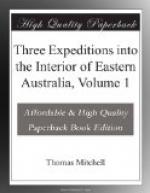I could not however perceive much current in these waters, and I traced the stream downwards, anxious to discover that this breadth and magnitude continued; but I was undeceived on arriving at a slight fall where the river was traversed by another rocky dyke similar to those seen higher up, and over which it fell in a small body like that in the rapid near the camp. Below this fall the river bore no such imposing appearance, but assumed that which it wore at the various places where we had visited its banks much higher up the stream. The meandering Gwydir terminated in this river a little way below the fall; and I could not perceive any difference in the appearance of the larger channel below that junction.*
(Footnote. The situation of this junction afforded a curious illustration of the principle which guided me in choosing my route from the great Namoi Lagoon on the 14th of January. Having been then between two rivers (at A) I chose the bearing of 20 degrees west of north, as given by the bearing of the high land (B) in the opposite direction, and this junction (C) was now found to be exactly in that line. That high land was a projecting point of a range; the course of rivers is conformable to the angles of such ranges, and therefore the rivers on each side of me (at A) were not so likely to come in my way in the direction of AC, as in any other direction I could have chosen. The chance of finding firm ground in that direction was also better as the rivers were only likely to continue separate by the protrusion of some remote offset of ground between them, from the salient feature B.)
Thus terminated our excursion to explore this last-discovered stream; for there was no necessity for extending it further, as I could not suppose that it was any other than the Darling. Into this river we had traced the Gwydir; the junction of the Namoi, also, could not be far distant; and even that of the Castlereagh was only about 70 miles to the south-west, which was the direction of the supposed general course of the Darling. It was probable that the streams we had now explored formed the chief sources of that river, and that we had connected its channel thus at an intermediate point, with the basin of all those rivers which had been crossed by Mr. Cunningham near the coast range above. It therefore remained for me only to return to the party, which had probably, by that time, finished the punt; and there to cross the river, in order to ascertain, by extending our journey, the nature of the country forming the northern or north-western side of this extensive basin.




